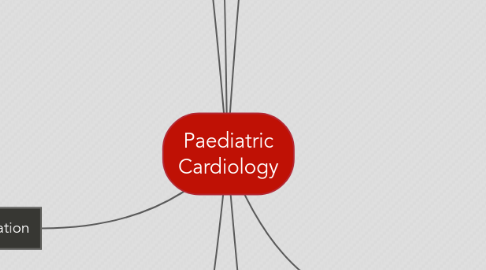
1. Congenital Heart Defects
1.1. Aetilogy
1.1.1. Genetic
1.1.1.1. Chromosomal anomalies account for 6-10% of CHD
1.1.2. Environmental
1.1.2.1. Drugs
1.1.2.1.1. Alcohol, Amphetamines, Illicit
1.1.2.2. Infections
1.1.2.2.1. Rubella, CMV, herpes, Toxoplasma
1.1.2.3. Maternal
1.1.2.3.1. DM, SLE
1.1.3. Teratogenic
1.2. 30% of live births
1.3. Trisomy 13- 90% ASD and VSD
1.4. Trisomy 18- 80% VSD and PDA
1.5. Trisomy 21- 40% AVSD- DOWN'S SYNDROME
2. Examination
2.1. Weight
2.2. Height
2.3. Cyanotic
2.3.1. Tetrology of Fallot
2.4. Clubbing
2.5. SOB
2.6. Pulses/Apex
2.6.1. Absent femoral pulse- Coarctation of Aorta
2.7. Heart Sounds
2.8. Murmurs
2.8.1. Timing- Systole/Diastole/Continuous
2.8.2. Duration- Early/Mid/Late or Ejection/Holo/Pansystolic
2.8.3. Pitch- Harsh/Soft
2.9. Dysmorphic Features-DOWNS
2.10. Oedema- Bilateral Pitting shows severe cardiac problems
2.10.1. Bi-ventricular failure
3. Invesitgations
3.1. BP
3.1.1. UL High or LL Low- Coarctation of Aorta
3.2. O2 Sats
3.3. ECG
3.4. CXR
3.4.1. Transposition of Great Vessels- EGG shaped appearance
3.4.2. Tetrology of Fallot- BOOT shaped appearance
3.5. Echo
3.6. Cath Lab
3.7. Angiography
3.8. MRI
3.9. ETT
4. Cyanotic Conditions
4.1. Tetrology of Fallot
4.1.1. Systolic Murmur
4.1.2. Pulmonary Stenosis, VSD, Overriding Aorta, RVH
4.1.3. Admit, O2, B-blocker, BT shunt (Subclavian A->Pulmonary A
4.2. Transposition of Great Vessels
4.2.1. No Murmurs
4.2.2. Ventilate + Prostoglandins
4.2.3. Scan- 2 parallel vessels on echo
4.2.4. Acidosis/Hypoxia
4.2.5. Surgical Treatment
5. Presentation:
5.1. Murmurs
5.1.1. 70-80%- INNOCENT MURMURS
5.1.1.1. Systolic
5.1.1.2. No other signs of cardiac disease
5.1.1.3. Soft murmur
5.1.1.4. Vibratory/musical
5.1.1.5. Localised
5.1.1.6. Varies with position, respiration, excercise
5.1.2. Stills Murmur
5.1.2.1. LV outflow murmur
5.1.2.2. Ages 2-7yrs
5.1.2.3. Apex, left sternal edge
5.1.2.4. Soft, systolic, increases in supine position w excercise
5.1.3. Pulmonary outflow murmur
5.1.3.1. Ages 8-10yrs
5.1.3.2. Soft, systolic, vibratory
5.1.3.3. Upper left sternal border, localised
5.1.3.4. Increases in supine w excercise
5.1.3.5. Child may have narrow chest
5.1.4. Carotid/Brachiocephalic arterial bruits
5.1.4.1. Ages 2-10yrs
5.1.4.2. 1/6-2/6 systolic- HARSH
5.1.4.3. Supraclavicular and radiates to neck
5.1.4.4. Increases w exercise and reduces when turning or extending neck
5.1.5. Venous Hum
5.1.5.1. Ages-3-8yrs
5.1.5.2. Soft, indistinct
5.1.5.3. Continuous murmur sometimes w diastolic attenuation
5.1.5.4. Supraclavicular
5.1.5.5. Only present when upright in position
5.2. Cyanosis
5.3. Failure to thrive
5.4. Rhythm Disturbance/ Collapse/Syncope
6. History:
6.1. Tachyopnea
6.2. Chest Pain
6.3. Syncope
6.4. Palpitations
6.5. Reduced ETT
6.6. Poor eating/feeding, weight gain and development
6.7. Join Problems
7. Acyanotic Conditions
7.1. Coarctation of Aorta
7.1.1. Present With collapse (4-10days)
7.1.2. No murmurs
7.1.3. Fluids don't help
7.1.4. Conservative management normally but may need surgical resection
7.2. VSD
7.2.1. Two types- Muscular and Perimembranous
7.2.2. Muscular uually small and closes spontaneously
7.2.3. Noticed at about week 3
7.2.4. Consequent Pulmonary Hypertension- no treatment, bi-ventricular hypertrophy
7.2.5. PAN SYSTOLIC MURMUR, left lower sternal edge w a thrill
7.2.6. Unclosed Left to Right shunt
7.2.7. Surgery for closure if not spontaneous- Patch/Amplatzer device
7.3. ASD
7.3.1. Two types- Osteum Primum from Septum Primum and Septum Secondum
7.3.2. Type 1- Mimics VSD in signs and consequences
7.3.2.1. ECG shows- Superior axis- left axis deviation w RV hypertrophy
7.3.3. Type 2- Often no signs may be identified in adulthood as AF, Ejection systolic
7.3.4. Good chance of closure spontaneously unless large
7.4. PDA
7.4.1. Ibprufoen and Indomethacin within 24hrs for closure
7.4.2. Continuous Murmur
7.4.3. Duct dependent conditions are an exception- transposition, hypoplastic, coarctation- PROSTOGLANDINS to open duct
